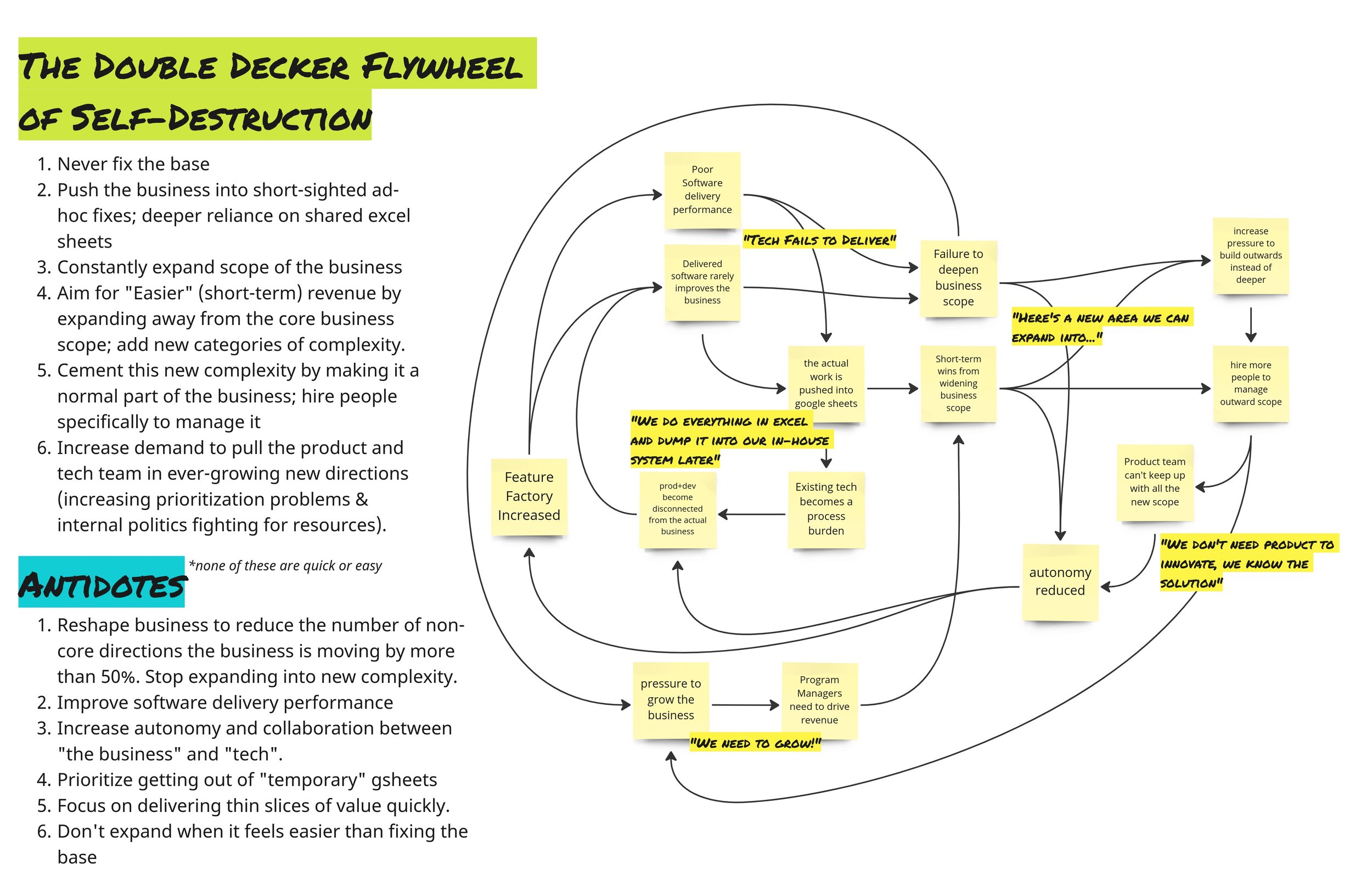The Double-Decker Flywheel Of Self-Destruction
Companies seeking growth often get “stuck”, unable to feel like they can really move forward effectively and simultaneously trying lots of new things to reach their growth targets. It’s an easy trap to fall into, and you’ll know if you’re in it because:
Your company is constantly adding new types of work, new “complexity cases”. Especially ones that are very different from your primary business.
New line of business, new branches of existing topics, more one-off projects to please a big potential customer that doesn’t mesh with the existing strategy, going deeper up or down the “supply chain” for the service they provide, and generally always expanding scope.
The Development and Product team can’t deliver fast enough and when they do deliver it is only a minor improvement to business outcomes (if anything at all).
Everything is an ad-hoc solution, usually in Google Sheets (or Excel) by an employee or manager from “the business” because of the point above.
There might even be pressure to hire a pirate tech team that writes software outside of the tech department.
Everyone does “the process” for handling day-to-day business differently, and nobody really knows why, and nobody knows how it all works. There always seems to be just one more person you need to talk to, but nobody knows who it is.
Everything seems to just be “stuck”. We can’t solve our biggest challenges, and those problems have been around for a long time, and the solutions feel really simple.
If that’s you, you’re fallen into the dreaded “The Double Decker Flywheel of Self-Destruction“.
It’s all too easy to land in this trap. The constant push for growth leads to searching for “low hanging fruits”, and when we face road blocks like “we can’t get what we need from tech”, it feels like the opportunity to look outside for “easier” targets is the right thing to do. Instead, the teams should all be focused on fixing why they can’t get results (either due to performance or too many competing initiatives). Often the hard conversations go unsaid and hard choices go unmade, so all the high-hanging-fruits rot on the trees while we go looking for more trees to move onto because we don’t know where to buy a ladder (or one of those tractors that shakes all the fruit off a tree in 3 minutes).
We end up in a situation where 75+% of the business happens outside of whatever the home-built solutions does, it is simply “there”. It usually gets in the way of work being done efficiently, but more critically it is often incapable of actually supporting the work. This leads to a lot of problem-solving outside of tech and the proliferation of shared google sheets with complex macros, and sometimes even someone who is “not a programmer (but I took a course once)” to end up writing a python script to and reduce their manual workload. These solutions get codified and locked-in to Standard Operating Procedures as the right way for work to get done. The gap between how things work and what the Product+Development think drifts wider and wider. As a real catch-22: this can often be accelerated when someone forbids use of building solutions outside of tech, simply driving these solutions into secrecy. The home-built solution is mostly used as a central database, and SOPs are full of hacks and work-around to deal with things it doesn’t do. Given enough time, those “work-arounds” are used so often everyone forgot it isn’t the right way to use the system, so nobody even talks about it any more.
The general situation is a constant pressure and reward for working on more than we can, and we re-enforce it by hiring people to be professional internal advocates for those topics, and we keep hunting outside of the existing scope for more quick-wins instead of fixing our basics. That’s the double flywheel of self-destruction in a nutshell.
There’s a set of common instincts and fallacies I’ve seen drag companies into this trap. Here’s some hints to stay out of the trap in the first place:
If you have slightly negative margins, adding a new line of business that also has a slightly negative margin is not going to fix anything
Don’t launch a new high-margin business because it looks good on reports, especially if the absolute revenue isn’t in the same ballpark, or if the cost to get it done will exceed the lifetime value. You can have loss leaders, but you usually don’t fall into the trap because you knowingly set up a loss leader.
Do not peruse “saving costs at any cost”. That SaaS you use might cost a lot of money, but building your own is far from free. Do a proper Due Diligence before going further, and calculate your opportunity cost
Don’t add a line of business just because you have someone who worked on that topic before and feels confident they can run it well
Don’t expand upstream or downstream from your supply chain because you understand or have exposure to those business models and feel like you can “do it”. (extreme example: a book publisher getting into harvesting lumber and opening a paper factory, and therefore an office supply store too)
Don’t reward throwing random stuff at the wall until something sticks. Work on a real strategy and take coherent action in a narrow & targeted space.
Be careful with sprawling complexity. Don’t be seduced by the prospect of increased short-term revenues on other topics because your core topic is too hard to improve due to internal issues. Work on your internal issues. It’s always good to start with the low hanging fruits… but don’t let the rest of that valuable crop rot on the branches.

